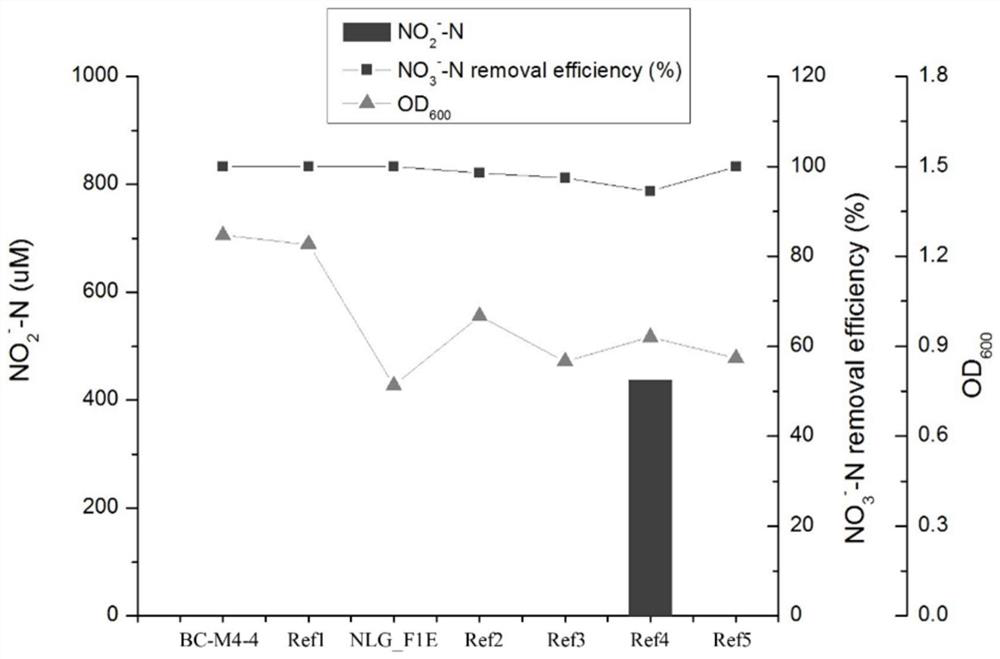Halomonas with aerobic denitrification and heterotrophic sulfur oxidation functions and application thereof
A technology of aerobic denitrification and Halomonas, which is applied in Halomonas and its application fields, can solve the problems of frequent occurrence, deterioration of breeding environment, and diseases of breeding animals, and achieve large biomass, convenient cultivation, and growth quick effect
- Summary
- Abstract
- Description
- Claims
- Application Information
AI Technical Summary
Problems solved by technology
Method used
Image
Examples
Embodiment 1
[0024] Example 1 Isolation and Identification of Halomonas sp. MCCC 1A17488 and MCCC 1A13718
[0025]1. Isolation of strains: The sulfide samples from the Tianxiu hydrothermal area in the Southwest Indian Ocean were collected, and the gradient dilution coating plate method was used to isolate and purify Halomonas sp. MCCC 1A17488 with Marine Agar solid medium. The Halomonas has been preserved in the Guangdong Microbial Culture Collection Center on March 27, 2020, and the preservation numbers are: GDMCC No: 60985. The deep-sea sediment samples in the Pacific Ocean were taken, and the gradient dilution coating plate method was used to isolate and purify Halomonas sp. MCCC 1A13718 by coating the plate with Marine Agar solid medium. The Halomonas has been preserved in the Guangdong Microbial Culture Collection Center on March 27, 2020, and the preservation numbers are: GDMCC No: 60984.
[0026] 2 Physiological and biochemical characteristics of the strain
[0027] Physiological ...
Embodiment 2
[0036] Example 2 Optimization of denitrification conditions of Halomonas sp. MCCC 1A17488 and MCCC 1A13718 in simulated wastewater
[0037] Scrape fresh bacteria from the MA plate, resuspend with sterile sea water, and adjust the bacterial concentration to 10 9 cfu / mL, according to the inoculum size of 0.2% to inoculate with 15mM NO 3 - -N or NO 2 - In the simulated wastewater of -N, the denitrification conditions of the strains were measured at different carbon sources, pH values, temperatures, salinities, and C / N ratios, and the denitrification conditions were optimized. Simulated wastewater composition: KH 2 PO 4 2g / L, Na 2 HPO 4 3g / L, MgSO 4 ·7H 2 O 0.05g / L, FeSO 4 ·7H 2 O 0.02g / L, CaCl 2 0.02g / L, distilled water 1000mL, sterilized at 121℃ for 20min. Nitrate nitrogen was determined by GB T12763 zinc cadmium reduction method; nitrite nitrogen was determined by GB7493-87-naphthaleneethylenediamine hydrochloride spectrophotometric method.
[0038] The results...
Embodiment 3
[0041] Example 3 Halomonas sp. (Halomonassp.) MCCC 1A17488 and MCCC 1A13718 Sodium Sulfide Oxidation Rate Determination
[0042] Halomonas sp. MCCC 1A17488 and MCCC 1A13718 were shaken and cultured in MB liquid medium for 24 hours, collected by centrifugation, washed twice with normal saline, and resuspended in HEPES buffer at pH 7.4 Make bacterial suspension, the final bacterial turbidity is OD 600 =2. Take 10mL of bacterial suspension, add freshly prepared sodium sulfide to start the reaction (final concentration is 1mM), and take samples at five time points of 0h, 0.5h, 1h, 1h, and 2h to determine the remaining concentration of sodium sulfide in the system. After the reaction was completed, the bacteria were collected by centrifugation again, washed twice in ultrapure water, transferred to a freeze dryer for 24 hours and freeze-dried, and the dry cell weight was measured. According to the change of sodium sulfide concentration and the dry weight of cells, calculate the ra...
PUM
 Login to View More
Login to View More Abstract
Description
Claims
Application Information
 Login to View More
Login to View More - R&D
- Intellectual Property
- Life Sciences
- Materials
- Tech Scout
- Unparalleled Data Quality
- Higher Quality Content
- 60% Fewer Hallucinations
Browse by: Latest US Patents, China's latest patents, Technical Efficacy Thesaurus, Application Domain, Technology Topic, Popular Technical Reports.
© 2025 PatSnap. All rights reserved.Legal|Privacy policy|Modern Slavery Act Transparency Statement|Sitemap|About US| Contact US: help@patsnap.com



